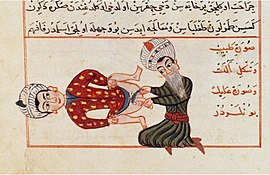
Back Kastrasie Afrikaans إخصاء Arabic Capadura AST Axtalama Azerbaijani Кастрацыя Byelorussian Кастрацыя BE-X-OLD Кастрация Bulgarian খোজাকরণ Bengali/Bangla Castració Catalan Dŏng CDO

| Part of a series on |
| Violence against men |
|---|
| Issues |
| Killing |
| Sexual assault and rape |
| Related topics |
Castration is any action, surgical, chemical, or otherwise, by which a male loses use of the testicles: the male gonad. Surgical castration is bilateral orchiectomy (excision of both testicles), while chemical castration uses pharmaceutical drugs to deactivate the testes. Castration causes sterilization (preventing the castrated person or animal from reproducing); it also greatly reduces the production of hormones, such as testosterone and estrogen. Surgical castration in animals is often called neutering.
Castration of animals is intended to favor a desired development of the animal or of its habits, as an anaphrodisiac or to prevent overpopulation. The parallel of castration for female animals is spaying. Castration may also refer medically to oophorectomy in female humans and animals.[1]
The term castration may also be sometimes used to refer to emasculation where both the testicles and the penis are removed together. In some cultures, and in some translations, no distinction is made between the two.
- ^ Simmer, H. H. (June 1983). "[Bilateral oophorectomy in the woman in late 19th century. Methodological value of castration for discovery of ovarian hormones]". Geburtshilfe Und Frauenheilkunde. 43 Suppl 1: 54–59. doi:10.1055/s-2008-1036594. ISSN 0016-5751.
© MMXXIII Rich X Search. We shall prevail. All rights reserved. Rich X Search